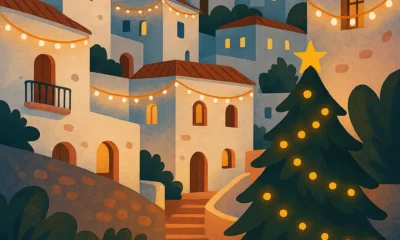Expats & Living
Affordable Homes Almeria: Expats Revive Rural Villages in 2025
Published October 7, 2025 | Category: Expats & Living
TL;DR: Dozens of inland villages in Almeria still face depopulation, but new initiatives — including Holapueblo, the regional strategy 2025-2030, and the Vivemás Andalucía housing portal — are creating real opportunities. Expats and young families are finding affordable homes in towns like Abrucena, Laujar de Andarax, and Las Negras, helping to revive rural life in southern Spain.
Affordable homes in Almeria: expats revive rural life through new opportunities
Table of Contents
- October 2025 update
- The demographic challenge in Almeria
- Abrucena: affordable living and skilled work demand
- Holapueblo’s new settlers in Laujar de Andarax and Las Negras
- Andalusia’s new rural strategy and the Vivemás Andalucía portal
- Housing market, vacant homes and fiscal incentives
- Why expats play a key role in rural renewal
- Challenges and the road ahead
October 2025 update
Since this topic first gained attention earlier in 2025, Almeria’s rural housing scene has evolved quickly. In September, the Junta de Andalucía officially launched the First Andalusian Strategy to Address the Demographic Challenge 2025-2030 in Almeria, alongside a new digital platform, Vivemás Andalucía, described as an “Airbnb for rural living.” This portal connects newcomers with municipalities, available homes, job opportunities, and local services. It marks a turning point in Andalusia’s commitment to repopulate the interior of provinces such as Almeria.
Meanwhile, initiatives like Holapueblo continue to bring new families — including foreign ones — to small Andalusian towns. Housing remains far more affordable than on the coast, and expats increasingly see rural Almeria as a place to settle, work remotely, or start small businesses.
The demographic challenge in Almeria
Almeria’s population imbalance has become one of Andalusia’s defining issues. While the province overall has grown to more than 777,000 inhabitants, its inland municipalities are losing people at an alarming rate. The Junta classifies 22 municipalities as being in a state of “red alert” for depopulation — meaning fewer births, higher unemployment, and accelerated aging.
Regions such as the Alpujarra Almeriense, Los Vélez, and the Nacimiento valley show the steepest declines. Many villages now have fewer than 1,500 residents. Yet this same trend has created an unexpected opportunity: these communities offer some of the most affordable homes in Almeria, often priced below €50,000 for purchase or around €300 per month for rentals — though supply is limited and renovation needs can be high.
Abrucena: affordable living and skilled work demand
The town of Abrucena, at the northern foot of Sierra Nevada, remains one of the most emblematic examples of rural renewal. Featured in El Español earlier this year, it continues to attract attention for its quality of life and housing affordability. Located just 67 km from Almeria city and well connected by road to Granada, Córdoba, and Jaén, Abrucena offers high-speed internet, 5G coverage, schools for all ages, and a daily taxi service to the provincial capital.
Rental listings cited in early 2025 mentioned homes for €300 per month, although availability varies and many properties require restoration. Still, compared to coastal areas such as Roquetas de Mar or Mojacar, the savings are enormous. The local economy also shows promise: there is demand for carpenters, plumbers, and electricians, as well as potential for wood-processing and small artisan businesses based on local forestry resources.
With orchards of cherries, almonds, and olives, Abrucena combines nature with potential for agro-tourism and food-based entrepreneurship. For expats seeking affordable homes in Almeria and the chance to build a new life, it represents a viable, community-oriented alternative to crowded coastal towns.
Holapueblo’s new settlers in Laujar de Andarax and Las Negras
According to Diario de Almeria and Idealista, the Holapueblo program — backed by Redeia, IKEA, and AlmaNatura — has helped 29 people settle in Andalusian villages in its first five years. Two of those families chose Almeria: one in Laujar de Andarax (inland Alpujarra) and one in Las Negras (in the Níjar coast). Both families established small businesses, including a ceramic workshop and local artisan projects.
The fifth edition of Holapueblo, published in mid-2025, confirms the program’s growing diversity. About 45% of participants are couples with children, 67% are aged 35-50, and 24% are foreigners — notably from Argentina, the United Kingdom, and the United States. Most of the projects launched by newcomers are led by women and focus on crafts, local food, or creative services. The result is a quiet but real transformation: new people, new jobs, and revived social life in villages once at risk of disappearing.
Holapueblo’s coordinators emphasize that success depends on community involvement. Municipalities that catalogue available housing, rehabilitate municipal homes, and provide administrative support attract more residents. In Almeria, towns like Laujar de Andarax have excelled at that approach — combining tradition, scenic beauty, and proactive local government.
Andalusia’s new rural strategy and the Vivemás Andalucía portal
In September 2025, the Junta de Andalucía presented the Andalusian Strategy against Depopulation 2025-2030 in Almeria. It includes 32 lines of action and a major digital innovation: the Vivemás Andalucía portal (vivemasandalucia.es), a website connecting potential settlers with more than 480 priority municipalities. The portal lists available homes, job offers, and business opportunities while promoting rural living as part of the campaign “El pueblo de tu vida.”
The government is also creating a catalogue of vacant housing to match supply and demand and is funding infrastructure improvements — from road upgrades to rural internet. This “Airbnb-style” approach to rural development signals a shift toward marketing small villages not as relics of the past but as viable lifestyle destinations for new generations and international residents.
Housing market, vacant homes and fiscal incentives
According to the most recent report by Comisiones Obreras Andalucía, Almeria has around 73,000 vacant homes — roughly 16.8% of its total housing stock, one of the highest rates in Andalusia. Many are located in rural areas, providing a potential base for revitalization. However, only about 8% of homes in Andalusia are long-term rentals, which means the rental market in small towns remains tight and often informal.
To encourage settlement, the Junta maintains major tax incentives for people buying property in small municipalities. Transfer tax (ITP/AJD) is reduced from 8% to 3.5% for homes under €150,000 in towns with fewer than 3,000 inhabitants, if used as a main residence. There are also subsidies of up to €10,800 for young buyers under 35, and 95% loan guarantees through Andalusian public banks.
Several municipalities have launched their own micro-initiatives. In the city of Almeria, for instance, the municipal developer “Almería XXI” has just completed 64 affordable rental apartments for young people, part of a larger effort to offer real housing solutions while complementing rural initiatives inland.
Why expats play a key role in rural renewal
Almeria’s low cost of living, good climate, and growing connectivity make it increasingly appealing to expats seeking authenticity and affordability. For remote workers, entrepreneurs, or retirees, small villages provide both peace and opportunity. The rise of digital work and flexible careers allows many to live anywhere — and for some, that means mountain views instead of city traffic.
Beyond economic impact, expats contribute cultural exchange, language skills, and new business models. In Laujar de Andarax, for instance, the arrival of a language school has benefited both locals and newcomers. Others are creating artisan workshops or eco-tourism ventures that draw visitors to places long forgotten on the map.
As housing pressure grows on the coast, these inland villages could become the next chapter of Almeria’s development — a blend of Spanish tradition and international community building.
Challenges and the road ahead
Despite progress, challenges remain. Many rural properties need substantial renovation, and essential services such as healthcare or public transport are still limited in remote areas. Successful repopulation depends not only on cheap housing but also on strong local engagement, clear administration, and sustainable job creation.
Still, optimism is rising. With Holapueblo expanding, the new Vivemás Andalucía portal active, and the Junta’s fiscal and social incentives in place, the stage is set for a new rural renaissance. Almeria’s small villages — from Abrucena to Laujar and beyond — may once again thrive, thanks to the blend of policy, community, and international newcomers ready to call them home.
FAQs: Moving to a village in Almeria
What is Vivemás Andalucía and how does it help Almeria’s villages?
Vivemás Andalucía is a regional portal launched in 2025 that lists homes, jobs, and services in 480+ rural municipalities. It helps newcomers — including expats — discover real housing options and opportunities in Almeria’s inland towns, and contact the local council or initiative directly.
Are there tax incentives for buying a home in small Almeria villages?
Yes. In municipalities with fewer than 3,000 inhabitants, transfer tax (ITP/AJD) can be reduced to 3.5% for purchases under €150,000 used as a main residence. Young buyers may also access subsidies and public mortgage guarantees (subject to eligibility and current rules).
Can foreign buyers (expats) qualify for these programs?
Generally, foreign buyers can purchase property in Andalusia and, if they become residents and meet the criteria (e.g., main residence, income limits for certain grants), they may qualify for regional or national aid. Always confirm current requirements before committing.
Do €300-per-month rentals still exist in villages like Abrucena?
€300/month was reported in early 2025 as an example for specific listings. Availability and conditions vary; some homes need renovation. Check recent listings and speak to the town hall or local agents for up-to-date offers.
Which Almeria villages have recently welcomed new residents through initiatives?
Through programs like Holapueblo, new families have settled in Laujar de Andarax and Las Negras. Abrucena is frequently highlighted for affordability, connectivity, and demand for skilled trades.
Explore more local life stories in our Expats & Living section, learn about housing and investments in Real Estate & Economy, and discover the charm of inland towns in Towns & Villages.
For more updates from across the province, visit our Expats & Living category.
Expats & Living
Embargos Bestiales Antas – Affordable Furniture and Home Goods in Almería
Published October 21, 2025 | Category: Expats & Living
TL;DR: Embargos Bestiales Antas is one of Almería’s best-known discount furniture and appliance stores, offering quality products from liquidations and stock clearances at great prices. A favourite among locals and expats alike. Editorial
Embargos Bestiales Antas – Affordable Furniture and Home Goods in Almería

Embargos Bestiales Antas has become a household name across the Levante region for those seeking quality furniture, home appliances, and décor at unbeatable prices. Conveniently located on the El Real Industrial Estate in Antas, this large showroom is part of the national Embargos Bestiales group, a trusted brand known for selling new and nearly new products from liquidations, end-of-line stock, and overproduction. The result is a constantly changing selection of stylish home essentials offered at discounts that often reach 50 % or more.
Everything for the Home – at Real Savings
The Antas branch carries a wide range of furniture and household products: sofas, armchairs, dining sets, beds, mattresses, wardrobes, kitchen units, and electrical appliances. Shoppers can also find televisions, washing machines, refrigerators, and decorative accessories such as lamps, mirrors, and artwork. Because stock comes directly from clearance lines and factory overstocks, no two visits are ever the same. Whether you are furnishing a new villa, equipping a rental apartment, or simply replacing a few items, Embargos Bestiales offers a reliable, budget-friendly solution.

Ideal for Expats and New Homeowners
For expats settling in Southern Spain, equipping a home can be one of the biggest early expenses. Many new residents arrive to find their property unfurnished, or in need of renovation. At Embargos Bestiales Antas, buyers can quickly furnish an entire house without exceeding their budget. The store’s multilingual staff assist both Spanish and foreign customers, ensuring a smooth shopping experience. Items can be delivered throughout the province, and the store offers flexible payment options and guarantees on most major appliances. The relaxed, no-pressure environment makes it especially popular among Northern European buyers looking for good value and friendly service.
Constantly Changing Stock and Weekly Offers
With deliveries arriving weekly, the showroom’s layout and inventory evolve constantly. Regular visitors often remark that “it never looks the same twice.” The company’s buying network across Spain and Europe allows the Antas branch to bring in stylish, high-quality pieces that would normally cost far more elsewhere. Many customers choose to follow the official Facebook page to stay informed about new arrivals, weekend offers, and limited-time promotions. The dynamic nature of the stock gives each visit a sense of discovery—part warehouse sale, part treasure hunt.
Location and Opening Hours
Embargos Bestiales Antas is located on the Polígono Industrial El Real, just minutes from the A7/E15 motorway exit. This convenient location makes it easily accessible from nearby towns such as Vera, Garrucha, Mojácar, and Cuevas del Almanzora. The store is open Monday to Saturday from 09:30 a.m. to 14:00 p.m. and from 16:00 p.m. to 20:30 p.m. Visitors can easily find the exact location via Google Maps directions by searching for “Embargos Bestiales Antas”. There is free parking directly in front of the store and plenty of space to load purchases.
Eco-Friendly and Smart Shopping
Beyond the savings, shopping at Embargos Bestiales also supports sustainability. Many of the items sold are overstock or unsold inventory that would otherwise go to waste. By giving these goods a second life, the company helps reduce unnecessary production and landfill. Customers appreciate that they can shop responsibly while still enjoying the thrill of a bargain. It’s an approach that aligns well with the eco-conscious mindset shared by many international residents in Almería.
Why It’s a Community Favourite
Over the years, Embargos Bestiales Antas has become more than just a furniture outlet—it’s a local institution. Its friendly staff, ever-changing inventory, and fair pricing have made it a trusted stop for both homeowners and landlords. The shop frequently receives repeat visits from customers who have furnished entire properties there and return whenever they need to refresh or upgrade. In a region where good value and service matter as much as sunshine, Embargos Bestiales Antas delivers both.
Visit Today
For anyone searching for affordable, quality home furnishings in Southern Spain, Embargos Bestiales Antas is well worth a visit. From essential appliances to statement furniture pieces, the store combines great prices with genuine customer care. Drop by the Antas showroom or browse the full catalogue at www.embargosbestiales.es for inspiration and current promotions.
Contact details:
Embargos Bestiales Antas
Polígono Industrial El Real, Calle Lugarico Viejo 2
04628 Antas (Almería), Spain
Tel: 950 105 711
WhatsApp: 662 632 322
For more updates from across the province, visit our Community category.
This article is a sponsored contribution by Embargos Bestiales Antas and does not necessarily reflect the views of VisitingAlmeria.com.
Expats & Living
Cabo de Gata cycling route. One of southern Spain’s most scenic rides
Published November 17, 2025 | Category: Expats & Living
TL;DR: A calm, scenic coastal ride through Cabo de Gata’s volcanic landscape. Gentle climbs, open views and smooth, low-traffic roads make it ideal for relaxed cycling or steady winter training.
The Cabo de Gata Cycling Route
The Cabo de Gata cycling route is one of the most iconic and enjoyable rides in the entire province. Combining volcanic cliffs, winding coastal roads and open Mediterranean views, it offers everything from relaxed touring to solid training kilometres. This is a route that both new residents and seasoned cyclists return to again and again — not only for the scenery, but for the peacefulness of riding through Spain’s largest protected coastal natural park.
In this comprehensive guide, you’ll find a detailed breakdown of the route, difficulty levels, road surface insights, optimal times to ride, wind patterns, safety notes and multiple route variations. Whether you’re new to cycling in Andalusia or looking for a winter base ride, this guide gives you everything you need.
Overview of the Route
The standard version of the Cabo de Gata cycling route begins in San Jose, a small coastal town known for its beaches and relaxed atmosphere. From here, the route heads south-east toward some of the park’s most dramatic viewpoints. Riders pass through quiet valleys, gentle climbs and open coastal stretches before reaching the fishing villages of Las Negras and Agua Amarga.
- Total distance: 35–55 km (depending on variation)
- Total climbing: 350–750 m
- Difficulty: Medium — accessible to most cyclists
- Best seasons: October–May
- Road surface: Smooth asphalt, well maintained
- Traffic: Very low outside summer
Because the gradients in this region rarely exceed 6–7%, it’s an excellent route for cyclists of mixed fitness levels. Stronger riders can extend the route beyond Rodalquilar or add side loops for extra elevation.
Section 1: San Jose → Playa de los Genoveses
The ride begins with an easy roll out of San Jose, gradually leaving behind the clustered white houses. Within minutes you enter the open volcanic landscape that defines Cabo de Gata. The road here is wide and smooth, with gentle curves and light elevation changes.
The stretch toward Playa de los Genoveses is a natural warm-up. You’ll see low hills on both sides, occasional agave plants and the first hints of coastline in the distance. Early in the morning, this area is particularly beautiful — golden light reflecting off the surrounding slopes and barely a car in sight.
Section 2: Genoveses → Mirador de la Amatista
After the Genoveses area, the road begins a gentle climb. This is where the scenery becomes more dramatic. A short but steady ascent takes you toward the Mirador de la Amatista, one of Cabo de Gata’s most recognised viewpoints. The climb is not difficult, averaging around 4%, but offers rewarding views across rugged cliffs and the Mediterranean Sea.
The viewpoint itself is a must-stop. On clear days you can see far along the eastern coastline and deep into the volcanic formations of the natural park. Many cyclists use this point for their first short break, especially during winter months when the light is crisp and visibility is exceptional.
Section 3: Mirador → Rodalquilar
The descent toward Rodalquilar is smooth and flowing, with broad sweeping curves. Visibility is excellent, making it one of the safest descents in the area. Rodalquilar is a quiet inland village with a rich mining history and a striking geological landscape. Surrounded by volcanic hills, it feels both remote and welcoming — a perfect midpoint for the route.
If you want to extend the ride, the inland loop north of Rodalquilar offers an additional 10–15 km and increased elevation. The road surface remains high quality and elevation stays steady rather than steep.
Section 4: Rodalquilar → Las Negras → Agua Amarga
From Rodalquilar, the route heads toward Las Negras, one of the most atmospheric coastal villages in Cabo de Gata. The road here is slightly rolling, with gentle curves and low traffic. Las Negras has several cafés, making it a popular coffee stop before continuing the ride.
The section from Las Negras to Agua Amarga is among the most beautiful of the entire route. The road hugs the cliffs and reveals wide panoramic views. Elevation changes remain friendly, although a few short ramps can surprise riders who are not expecting them.
Agua Amarga is a serene village with a small beach, whitewashed houses and a relaxed coastal vibe. Many cyclists choose to turn back here, while others loop inland for more climbing.
Difficulty and Who This Route Is For
The Cabo de Gata cycling route is classified as medium difficulty. It’s perfect for:
- Recreational cyclists
- Expats enjoying winter riding
- Touring cyclists exploring Andalusia
- Riders seeking a safe low-traffic environment
There are no extreme gradients, and the total elevation is manageable. The challenge comes mainly from distance and exposure to wind, rather than steep climbing.
Weather: Wind, Seasons and Conditions
One of the key factors in planning any ride in Cabo de Gata is the wind. Two main patterns dominate:
- Poniente wind: A westerly wind that brings cooler, clearer conditions. Ideal for riding.
- Levante wind: An easterly wind that can be strong and gusty, especially along open coastal sections.
For the most comfortable experience, check the official AEMET forecast before departure.
The best seasons are autumn, winter and spring. From October through May, temperatures range between 14°C and 22°C — nearly perfect for endurance sessions. Rainfall is extremely low, giving Almeria one of the most reliable winter cycling climates in Europe.
Road Safety and Surface Conditions
The entire route benefits from smooth asphalt and well-maintained infrastructure. Shoulders are narrow, but the roads are wide enough for comfortable cycling. Because cars are rare outside the summer months, it feels exceptionally safe.
Always bring enough water: certain stretches between villages have no services for several kilometres. Mobile coverage is generally good, but not perfect in deep valleys.
Recommended Gear
- Tyre width: 25–28 mm is ideal for comfort and grip.
- Lights: Useful for low-light winter mornings.
- Wind jacket: Essential if riding during Levante conditions.
- Two bottles: Especially if extending the route.
Route Variations
- Short route: San Jose → Mirador → Rodalquilar (35 km)
- Medium route: San Jose → Las Negras → Agua Amarga (45–55 km)
- Extended climbing loop: Add Rodalquilar inland loops (+10–20 km)
One of the most complete and scenic rides
The Cabo de Gata cycling route is one of the most complete and scenic rides available in southern Spain. With open views, low traffic, flexible distance options and mild year-round weather, it appeals to cyclists of all levels. For cyclists who live in Almeria and for those just visiting, this route offers a relaxed, scenic ride that’s easy to enjoy.
For more updates from across the province, visit our Expats & Living category.
Expats & Living
Location Auctions Antas – Fortnightly Household Auctions in Almeria
Published November 10, 2025 | Category: Community
TL;DR: Location Auctions Antas, managed by Mark Seigne of Location Warehousing S.L., runs live fortnightly auctions of household goods in Antas. It’s a friendly, family-run event where locals and expats can buy and sell quality items, discover bargains, and enjoy a lively community atmosphere. Editorial

Location Auctions Antas – Fortnightly Household Auctions in Almería
Location Auctions Antas has become a familiar name across Eastern Almeria, known for its professional organisation, fair prices, and friendly spirit. Operated by Location Warehousing S.L.—a family business founded more than twenty years ago by David Seigne and now managed by his son Mark—the auction division is a natural extension of the company’s long-standing commitment to service, reliability, and community values. What began as a small, local initiative has grown into one of the most popular regular events in the region, drawing visitors from Antas, Vera, Mojácar, and beyond.
A Trusted Family Business with Local Roots
The Seigne family established Location Warehousing to provide dependable removals and storage services for residents and expatriates in Southern Spain. Over time, the company’s success created a new opportunity: offering a way for people to buy and sell second-hand items safely and transparently. Thus, Location Auctions Antas was born. The auctions take place at the company’s spacious warehouse on the El Real Industrial Estate, just off the A7/E15 motorway. The site offers excellent access, plenty of parking, and a welcoming environment that has become synonymous with trust and quality. Mark Seigne and his dedicated team have built on David’s original vision—combining professionalism with the warmth of a true family business.
What You’ll Find at the Auctions
Each fortnight, the Antas warehouse transforms into a buzzing marketplace filled with hundreds of lots. From sofas, tables, and white goods to paintings, power tools, garden furniture, and collectables, there is something for everyone. Many items come from house clearances, relocations, or downsizing clients, while others are consigned directly by local residents. Every auction brings new surprises: a restored vintage cabinet, a classic bicycle, or perhaps a one-of-a-kind Andalusian artwork. For newcomers settling into the Almería region, the auctions offer a cost-effective, sustainable way to furnish a home while meeting friendly faces from the local community.
How to Take Part
Joining the excitement is simple. Buyers register on arrival, receive a numbered paddle, and can then bid freely during the live event. The experienced auctioneer guides proceedings with humour and clarity, ensuring newcomers feel comfortable and returning bidders stay entertained. Once an item is sold, payment is made on-site and collection usually follows the same day. Sellers can deliver their goods in advance, and the Location team handles cataloguing, secure storage, and presentation. Commissions are modest and clearly explained, reinforcing the company’s reputation for transparency and fairness.
Secure, Professional, and Fully Insured
Because the auctions operate under the umbrella of Location Warehousing S.L., every detail benefits from the same rigorous standards of safety and care. The Antas premises are alarmed, insured, and directly connected to the local police. Goods remain protected until sold, and the entire process—from intake to sale—is carefully monitored by Mark’s staff. This professionalism has earned the trust of hundreds of repeat customers, many of whom have supported the event for years. It’s this consistency, coupled with genuine friendliness, that keeps Location Auctions Antas a step ahead of typical second-hand markets.
Community Spirit and Sustainability
Beyond the buying and selling, the auctions have become a true social occasion. Locals drop by to browse, chat, and enjoy coffee while the bidding unfolds. The atmosphere is lively yet relaxed—an ideal Wednesday morning activity that blends practicality with entertainment. For expats, it’s also a gateway into the local community and an easy way to integrate into Spanish life. On a broader scale, the auctions promote sustainability by giving used items a second life. This circular approach reduces waste, supports mindful consumption, and contributes to the eco-friendly values many Almería residents share.
From Household Goods to Hidden Treasures
Part of the fun lies in the variety. One week the warehouse might be filled with garden sets and kitchen appliances, the next with paintings, musical instruments, or even motorbikes. Every event offers something unexpected. Seasoned bidders and first-time visitors alike describe the experience as both enjoyable and addictive. “You never know what will come through the doors,” says Mark Seigne. “That’s what keeps people coming back.”
Visit the Next Auction
The auctions are held every 14 days at Location Warehousing’s main site in Antas. Doors usually open mid-morning for public viewing, with the live sale beginning at 10 a.m. Entry is free, and there’s ample space to browse before bidding begins. Full details, including upcoming dates and preview photos, are posted regularly on the official Location Auctions Antas Facebook page. Bargain hunters, home improvers and the simply curious will find these auctions a memorable glimpse of local life in Almería — friendly, authentic and full of surprises.
Contact details:
Location Auctions Antas
Polígono Industrial El Real, Calle Mojana 9
04628 Antas (Almería), Spain
Tel: +34 697 980 061
View on Google Maps
Facebook: Location Auctions Antas
For more updates from across the province, visit our Community category.
This article is a sponsored contribution by Location Warehousing S.L. and does not necessarily reflect the views of VisitingAlmeria.com.
Expats & Living
Almeria Airport Winter 2025: New UK Routes Boost Flights by 12%
Published November 1, 2025 | Category: Infrastructure
TL;DR: Almeria Airport launches its new 2025–26 winter schedule with record growth — two new UK routes to Liverpool and Bristol bring a 12% rise in available seats and 10% more flights compared to last winter.
Almeria Airport Winter 2025: New UK Routes Boost Flights by 12%
The winter flight schedule for Almeria Airport (LEI) has officially begun with significant growth, according to Aena and Spain’s Ministry of Transport. For the 2025–26 season, airlines have scheduled a total of 284,000 seats and more than 2,600 operations to and from Almeria — a year-on-year increase of 12.4% in capacity and 10.7% in flights.
Table of Contents
- 1. Overview of the 2025–26 Winter Season
- 2. New UK Routes: Liverpool and Bristol
- 3. Domestic and International Breakdown
- 4. Economic and Tourism Impact
- 5. Regional Context and Airport Performance
- 6. Looking Ahead to 2026
1. Overview of the 2025–26 Winter Season
Almeria Airport’s new winter schedule — running from late October 2025 through March 28, 2026 — reflects a coordinated effort to expand the city’s air connectivity and reduce tourism seasonality. The airport will operate a total of 284,000 available seats across domestic and international routes, confirming Almeria’s growing importance as both a tourism and business hub in southeastern Spain.
The airport director, Ignacio Tejero, expressed optimism in a public statement, highlighting “the aviation sector’s renewed confidence in Almeria and the strong cooperation between airlines, tourism boards, and regional authorities.”
2. New UK Routes: Liverpool and Bristol
This season introduces two new routes connecting Almeria directly with the United Kingdom: Liverpool and Bristol. These additions build upon existing services to London (Gatwick), Madrid, Barcelona, Melilla and Palma de Mallorca, expanding Almeria’s reach within the UK market — a key source of year-round visitors to Andalusia’s coast.
As previously reported in our coverage of EasyJet’s Liverpool–Almeria route, the airline expects strong demand throughout winter 2025–26. The new Bristol service further strengthens the province’s connectivity to western England, complementing the popular London and Liverpool routes already in operation.
Both routes are operated by EasyJet and are scheduled to run twice weekly during the winter season, connecting UK passengers directly to Almeria’s tourism hubs — including Roquetas de Mar, Mojácar, El Toyo, and Vera.
3. Domestic and International Breakdown
Of the total 284,000 available seats, 222,844 correspond to domestic flights (+1.9% year-on-year), while 61,190 are allocated to international operations — a staggering +80.2% compared with last winter. This surge is largely driven by the UK market and charter services expanding into northern Spain and select European cities.
In addition to regular scheduled flights, charter connections will continue throughout the season to destinations such as A Coruña, Vigo and Zaragoza, along with occasional one-off operations to Berlin, Istanbul, Marrakech and Tetouan. These ad hoc routes highlight Almeria’s increasingly diverse connectivity profile.
4. Economic and Tourism Impact
The new winter flight programme is a clear indicator of confidence in Almeria’s tourism potential. The Junta de Andalucía estimates that each 10% increase in air capacity generates roughly 30,000 additional overnight stays in the province. By that measure, the airport’s current growth could contribute up to 90,000 extra hotel nights over the next five months.
Local tourism operators in El Toyo, Mojácar, Roquetas de Mar and Vera — areas that traditionally slow down after summer — expect this schedule to help extend the season. British and northern European travellers remain the primary targets, as Almeria continues to market itself as a “sun-all-year” destination.
Hotel associations such as ASHAL (Asociación de Hostelería de Almería) have also welcomed the increased air connectivity, citing higher winter bookings and stronger interest in mid-range resort stays.
5. Regional Context and Airport Performance
Nationally, Spain’s airports managed by Aena are experiencing similar trends. The operator reported that for the 2025–26 winter season, Spanish airports overall will handle 3.5% more seats and 3.3% more operations than last year — continuing a post-pandemic expansion that began in 2023. (Aena Press Release, Oct 2025).
According to the MITMA Air Traffic Report (July 2025), Almeria registered nearly one million passengers between January and September 2025, an 11% increase over the same period in 2024. The upward trend is expected to continue through the end of the year, supported by renewed international demand and improved domestic connectivity.
6. Looking Ahead to 2026
With the new routes and increased flight frequencies, Almeria Airport is positioned for sustained growth heading into 2026. The introduction of additional UK services may pave the way for further connections to northern Europe — including potential seasonal routes to Manchester and Amsterdam.
Furthermore, ongoing works at the future AVE high-speed rail station in Almeria will improve intermodality between air, train and road transport by 2027, enhancing accessibility and reinforcing the airport’s strategic role in southeastern Spain.
For now, the expansion of Almeria Airport’s winter schedule is both a logistical and symbolic milestone: proof that the region’s tourism and transport sectors are thriving well beyond the traditional summer season.
For more updates from across the province, visit our Infrastructure category.
-

 Infrastructure6 days ago
Infrastructure6 days agoMurcia–Almería High-Speed Rail: €9.6 Million in New Funding
-

 Events6 days ago
Events6 days agoMojácar Christmas 2025: Disney Day & Official Lights Switch-On
-

 Events5 days ago
Events5 days agoTerreros Slalom 2025: 35 Drivers Compete in a Key Andalusian Championship Round
-

 Community5 days ago
Community5 days agoDisney in Almeria: The Forgotten Story of the Park That Almost Happened
-

 Expats & Living6 days ago
Expats & Living6 days agoEmbargos Bestiales Antas – Affordable Furniture and Home Goods in Almería
-

 Towns & Villages1 day ago
Towns & Villages1 day agoVera Nativity Scene 2025: A Monumental Journey to Ancient Rome















